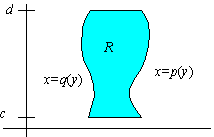Part 4: Volumes of Solids over Type II Regions
Similarly, if p( y) £ q( y) for y in [ c,d] , then the region R in the xy-plane bounded by the
curves x = p( y) and x = q( y)
from y = c to y = d,

is said to be a type II region. Correspondingly, if f(x,y) ³ 0 for all ( x,y) in a type II region R, then
the volume of the solid under z = f( x,y) and over the region R
is
|
V = |
ó
õ
|
d
c
|
|
ó
õ
|
q( y)
p( y)
|
f( x,y)dxdy |
| (2) |
EXAMPLE 6 Find the volume of the solid under the graph of f( x,y) = x2+y2 over the type II region
Solution: To do so, we use (2) to see that
|
V = |
ó
õ
|
1
0
|
|
ó
õ
|
y
y2
|
( x2+y2) dxdy |
|
Evaluating the innermost integral leads to
|
|
|
|
|
ó
õ
|
1
0
|
|
é
ë
|
|
x3
3
|
+xy2 |
ê
ê
|
y
y2
|
ù
û
|
dy |
| |
|
|
|
ó
õ
|
1
0
|
|
é
ë
|
|
4
3
|
y3- |
1
3
|
y6-y4 |
ù
û
|
dy |
| |
|
|
|
Finally, let us note that unbounded regions can lead to convergent
improper integrals. Indeed, unbounded solids can have a finite volume.
EXAMPLE 7 Find the volume of the solid under the graph of f(x,y) = e-x-y over the first quadrant.
Solution: In the first quadrant, x is in ( 0,¥) and y is in ( 0,¥) . Thus, (2)
implies that
|
V = |
ó
õ
|
¥
0
|
|
ó
õ
|
¥
0
|
e-x-ydydx |
|
The inner integral is evaluated as an improper integral
|
|
|
|
|
ó
õ
|
¥
0
|
|
lim
R® ¥
|
|
ó
õ
|
R
0
|
e-x-ydydx |
| |
|
|
|
ó
õ
|
¥
0
|
|
lim
R® ¥
|
(e-x-0-e-x-R) dx |
| |
|
|
|
The resulting integral is also evaluated as an improper integral, leading to
|
V = |
lim
S® ¥
|
|
ó
õ
|
S
0
|
e-xdx = |
lim
S® ¥
|
( e0-e-R) = 1 |
|

